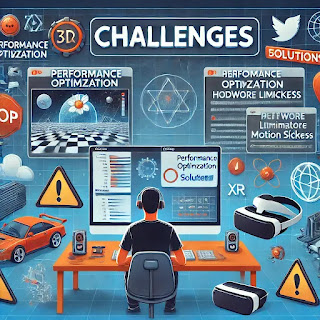Day 7: Common Challenges in VR, AR, and XR Development and How to Overcome Them
As exciting as VR, AR, and XR development can be, it comes with its own set of challenges. Developers often encounter hardware limitations, software bugs, and performance optimization issues. In today’s post, we’ll dive into the most common hurdles in XR development and provide actionable solutions to help you navigate them.
1. Hardware Limitations
-
Challenge:
- High-quality VR/AR devices can be expensive and not always accessible for developers or users.
- Limited battery life or computational power in standalone devices.
-
Solutions:
- Start with budget-friendly hardware like Oculus Quest 2 or smartphones for AR.
- Optimize applications to run on a range of devices, ensuring compatibility with lower-end models.
💡 Pro Tip: Use cloud rendering services like NVIDIA CloudXR to reduce the dependency on local device power.
2. Performance Optimization
-
Challenge:
- Maintaining high frame rates (e.g., 90 FPS for VR) is critical to avoid motion sickness.
- Heavy 3D assets can lead to slow load times or performance drops.
-
Solutions:
- Optimize 3D models by reducing polygon count.
- Use techniques like Level of Detail (LOD) to load simpler assets for distant objects.
- Test on multiple devices to ensure smooth performance.
💡 Tools to Help:
- Unity’s Profiler and Unreal Engine’s Performance Analyzer for pinpointing bottlenecks.
3. Software Bugs and Glitches
-
Challenge:
- Tracking inconsistencies or crashes can break the immersive experience.
- AR content might not align perfectly with real-world surfaces.
-
Solutions:
- Implement rigorous debugging and testing workflows.
- Use robust SDKs like ARCore and ARKit, which provide reliable tracking algorithms.
- Regularly update device firmware and SDKs to benefit from the latest improvements.
4. Usability Issues
-
Challenge:
- Complex controls or unintuitive interfaces can frustrate users.
- Lack of accessibility features limits usability for individuals with disabilities.
-
Solutions:
- Focus on user testing and gather feedback to simplify navigation and controls.
- Include accessibility options like voice commands, customizable controls, and adjustable text sizes.
💡 Tip: Build your app with inclusivity in mind from the start.
5. Content Creation Bottlenecks
-
Challenge:
- Designing 3D assets and animations can be time-consuming and require specialized skills.
-
Solutions:
- Leverage asset stores like Unity Asset Store and TurboSquid for pre-made models.
- Use AI-powered tools like RunwayML to assist with content creation.
6. Limited Cross-Platform Compatibility
-
Challenge:
- Developing for multiple platforms (e.g., iOS, Android, Oculus) can be complex and time-intensive.
-
Solutions:
- Use cross-platform frameworks like Unity’s AR Foundation or OpenXR to streamline development.
- Modularize your codebase to accommodate platform-specific adjustments.
7. Lack of Real-World Testing
-
Challenge:
- Simulating real-world conditions for AR apps (e.g., lighting, surface detection) can be difficult in controlled environments.
-
Solutions:
- Test applications in varied environments (e.g., outdoors, dim lighting) to refine performance.
- Use emulators and simulators provided by ARCore and ARKit to replicate real-world conditions.
8. Motion Sickness in VR
-
Challenge:
- Rapid movement or low frame rates can cause discomfort or nausea.
-
Solutions:
- Limit sudden camera movements in VR experiences.
- Offer teleportation as an alternative to continuous movement.
- Ensure a minimum frame rate of 90 FPS to reduce discomfort.
Final Thoughts
Challenges in XR development can be daunting, but they’re also opportunities to refine your skills and create better experiences. By proactively addressing these issues, you can build immersive applications that are not only engaging but also accessible and reliable.
What’s Next?
In tomorrow’s post, we’ll explore the ethical considerations of VR, AR, and XR, discussing privacy, inclusivity, and the social impact of immersive technologies. Don’t miss it!
